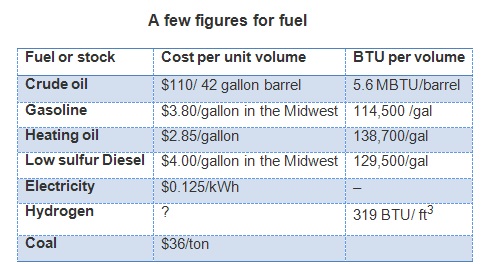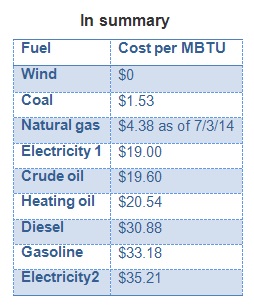A writer in California recently complained of high power costs and that they were too infrequently mentioned in power industry discussions. He is right. Everything has a cost and value, and it’s skimmed over too often. The most insightful and respected economist of our era, Milton Friedman, often asked after hearing suggestions for action on some dubious matter: At what cost?
So let’s talk about costs for fuels and what would produce the lowest cost power. A report from the U.S. Energy Information Administration reports on the costs of some common fuels and fuel stocks, such as crude oil, gasoline, heating oil, and low sulfur diesel. But all the volumes are different. To make comparisons it is necessary to convert to dollars per million BTUs. Start with this table sourced from EIA data:

All costs per unit volume are from Midwest sources or reported by EIA, http://www.eia.gov/todayinenergy/prices.cfm
These are world commodities so their prices change on a daily basis. There is a wide range to the quality of coal because it’s a product of nature, so its thermal and sulfur content vary as does cost, from $13 to $60/ton. Hence, the middle value. See www.eia.gov/coal/news_markets/ for a single small table with comparable figures.
A few conversion factors are needed to complete the comparison, such as
3,413 Btu/ kWh, 42 gallon per barrel of crude, and let MBTU = million BTUs. Other interesting values are here: http://www.physics.uci.edu/~silverma/units.html
To find the cost of 1 MBTU, use the equation
Cbtu = ($/gallon) / (MBTU/gal)
The second quantity in the equation comes from the third column in the table. Recall that when dividing by a fraction, invert it and multiply.
So, 1 MBTU for crude oil:
Cbtu-co = $110/barrel x 42 gallons/barrel x 1 barrel/5.6 MBTU
= $19.6/MBTU
For gasoline:
Cbtu-g = $3.80/gal x 1 gal/ 0.1145 MBTU
= $33.18/MBTU
For heating oil
Cbtu-ho= $2.85/gal x 1 gal/ 0.1387 MBTU
= $20.54/MBTU
For diesel:
Cbtu-d = $4/gal x 1 gal/0.1295 MBTU
= $30.88 / MBTU
For coal:
Cbtu-c = $36/ton x 1lb/0.0117 BTU x 1 ton/2,000 lb
= $1.53 / MBTU
Electric bills in the Midwest report the power production cost (Cep) about 6.5 ¢/kWh. Transmission (Ct) just about doubles the figure.
Cbtu-ep = $0.065/kWh x 1kwh/ 3,413 BTU
= $19/MBTU
The same electric bills put transmission costs at 6.0 ¢ /kWh. So, power from the plug is:
Cbtu-ep+t = $0.125 / kWh x 1 kWh/3,413 BTU
= $35.215 / MBTU
This last table deserves some comment because while the fuels look cheap, they have not been turned into electricity, and that is the trick.
What is remarkable on first sight is the low cost of coal BTUs, but, coal must be shipped to a power station which adds to its cost. Then turning it into electricity produces the cost figure at the table bottom at Electricity2, the cost for production and transmission, and what you pay for it from an outlet in your home. In fact, despite a drop in fuel costs, don’t expect the Electricity2 figure to drop because utility assets must be maintained and replaced, and competition from smaller power producers (solar and micro grids) is likely to increase all while the economy is darn near stagnant.
Burning natural gas will also produce the Electricity2 figure despite its advantages over coal: no ash to carry away, no scrubbers to maintain, and its transport is less costly.
Electricity1 is the cost for power from a mix of sources as reported by our Midwest electric bill.
When diesel fuel is consumed in diesel-driven generators, its resulting cost of electricity would about double the figure for Electricity1. The rate quoted for diesel generated power on islands is often at least $0.50/kWh.
What does all this mean? Electricity that we buy is a bargain because it is converted into useful work with efficiency greater than other fuels. Sadly, government edicts are working to drive its cost up, while worldwide competition and U.S. ingenuity is working to drive costs down.
If coal is to be pushed aside, the table also shows that wind and natural gas together can provide the least expensive power and should be allowed to do so. Look for a news story in the upcoming issue on a natural-gas powered engine intended to spin multi-megawatt generators that can follow grid loads and compliment naturally variable, wind-generated power. Natural gas and wind power are the utilities’ future, at least for the next couple decades.
–Paul Dvorak
Filed Under: News





